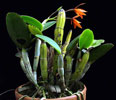|
|
|
|
|
| |
Flasks of
Cattleya aurantiaca 'Gollum' × self |
|
| |
|
|
| |
| Number: |
TN3176 |
| Name: |
Cattleya aurantiaca 'Gollum' × self
|
| Type: |
self (What's that?) |
|
Seed Donor: |
Dale Borders
|
|
Click to Enlarge

Pod Parent Flowers |
Click to Enlarge

Pod Parent Blooming Plant |
|
|
|
| |
Culture Notes from Donor: Parent plant: Temperature range I (60-83°F)
Comments: Parent plant: This plant is a recent import from a salvage operation and appears to be a dwarf cultivar. After one year in cultivation, growths continue to be very short, although sufficiently large to bloom. The blooming growth is 4" (10.1 cm) tall.
For additional origin/habitat information supplied courtesy of
Charles and Margaret Baker, see further below, near the bottom of this page.
|
Temperatures we attempt to use in the lab & greenhouse:
| For Species: |
|
Spring, Summer, Autumn, Winter: days average 80°F, nights 58°F; best fit is cool-intermediate 75-58°F
(Source:
Baker's Web OSC) |
| For Genus: |
|
Spring, Summer, Autumn, Winter: days average 83°F, nights 60°F; best fit is Intermediate 83-60°F
(
) |
|
About the name...
| Etymology of |
aurantiaca |
|
From Latin "aurantiacus" dead gold, yellow-orange.
(Source:
Mayr & Schmucker 1998) |
| Etymology of |
Cattleya |
|
Named in honor of William Cattley, English horticulturist in the 19th century.
(Source:
Pridgeon 1992) |
| Pronunciation of |
aurantiaca |
|
aw-ran-tee-AH-ka
(Source:
Hawkes 1978) |
| Pronunciation of |
Cattleya |
|
KAT-lee-ya
(Sources:
Pridgeon 1992, Hawkes 1978) |
|
If you would like to direct someone to this web page, please copy and paste this URL into your email:
http://troymeyers.com/d?013176
| Flask Information |
| Availability: |
We have sold all of the flasks for this item. |
| You should: |
Consider getting individual plants or compots instead of a flask.
You can place a "Notify Flask Recipients" Request, and either we or a flask recipient may contact you when plants are available.
You may also place a "Notify Retries" Request, and if an identical pollination (the same parents) is done again, we'll let you know.
You may reserve a flask, but it's very unlikely you'll get one ...this could only happen if we found a flask that we didn't know we had. |
| Yield Estimate: |
420 plants (based on flask surveys done 08/15/2006 through 01/04/2008)
|
| Plantlet Sizes: |
From many flasks 5 - 90 mm plants (based on flask surveys done 01/29/2007 through 09/23/2008)
From one most recently surveyed flask 20 - 60 mm (09/23/2008)
|
|
You might also want to:
|
View the seed assay for this item.
View items of the same species.
View items of the same genus.
|
| Ordering Information |
| You are not currently logged in. |
|
You must be a registered user and be logged in to reserve a flask or place a notification request. Please log in:
|
|
|
|
|
|
| |
The origin/habitat information below is supplied courtesy of Charles and Margaret Baker
The following information is based on the name of the plant provided by the donor, and assumes that the name is correct. If the plant has been misidentified, then the following information may not be correct.
This text is copyrighted by the Bakers and may not be reproduced without permission.
ORIGIN/HABITAT: Mexico, Guatemala, El Salvador, Honduras, and Nicaragua.
In Nicaragua, plants grow on trees in dry hilly pastures and in roadside
forests. Near Matagalpa and Managua they have been found at 1950-3300 ft.
(600-1000 m). In Mexico, plants grow on trees on protected hillsides and
in stream-valleys at 1000-3600 ft. (300-1100 m) on Pacific-facing slopes.
The habitat extends from the State of Sinaloa southward to the border with
Guatemala. Plants are also reported on the Revillagigedo Islands, which
are located about 450 mi. (725 km) off the coast of the State of Colima.
More about this information and the Bakers...
|
|
|
| |
|
|
|